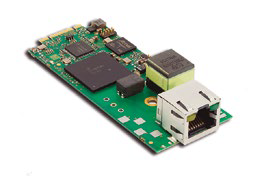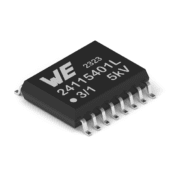Despite the fact that machines, equipment, components and people are increasingly connected wirelessly, there is still no alternative to wired communication in many industrial environments. The most appropriate transmission standard depends on the specifics of the application scenario. A few basic considerations help in decision making.
Symmetrical DSL transmission technology SHDSL (Single-Pair High Speed Digital Subscriber Line) is unbeatable when it comes to achieving long range over copper cables. ISDN (ISDN) is no longer available as an alternative because the standard and the corresponding circuits have left the market and existing solutions have to be replaced by 2022 at the latest. With low data rates, SHDSL can cover up to 20 km at over twisted copper pairs; in practice, it can reach 40 km. This makes it the ideal standard for applications where small volumes of data, such as sensor information, are sent from remote locations and few control commands are returned, such as in pipeline monitoring and control units. Another advantage for such applications is that SHDSL guarantees robust communication, even under difficult conditions, such as where electromagnetic interference exists. SHDSL is also the preferred standard in camera systems, such as surveillance cameras, and Smart City applications (smart cities) or underwater and underground oil and gas exploration, where data has to be transmitted over a hundred meters. As data rates increase, the range is reduced, depending on the cable specification, but up to 15 Mbit/s can usually be sent over copper wire without any problems in real world conditions. Therefore, it is quite superior to other standards. To achieve optimal SHDSL performance, the software must be tailored as precisely as possible to the specific application. This is so because, instead of telephone lines with a typical wire diameter of 0,4 mm, other wiring is often used (with, for example, much thicker cables). A great benefit of this technology is that it offers a good number of configuration options. So measurements on the lines are very useful in taking into account specific characteristics such as attenuation and spectral bandwidth and optimizing modulation to increase performance and stability.
Tried and tested solution for SHDSL
The quasi-standard component for SHDSL transmission is Intel's SHDSL PEF2x628 chipset – better known by its original name SOCRATES, with which Infineon brought it to market a few years ago. The established solution for EFM (Ethernet First Mile) system applications provides users with the benefits of a mature and proven technology that enables short time-to-market. It achieves data rates of up to 15 Mbit/s per copper wire pair with a freely selectable bit rate and can be used as an EFM modem, SHDSL EFM module or plug&play Ethernet extender. Apart from SHDSL, the chipset also supports ETSI (SDSL and SDSL.bis), ITU (G.shdsl, G.shdls.bis and G.hs) and IEEE EFM standards. Additionally, it is available as a four-channel solution, allowing data rates of up to 60 Mbit/s to be achieved over four wire pairs.
WAN connectivity for industrial routers and gateways
The situation is different when it comes to routers or industrial gateways. They are focused on enabling high transmission rates; range is usually less important. The current VDSL2 standard (Very High Speed Digital Subscriber Line) achieves bit rates of up to 400 Mbit/s over short lines using a spectral bandwidth of up to 35 MHz, depending on the profile and the combination with vectoring or supervectoring. However, performance is split between upload and download rates. This division depends on the port configuration, but the download rate is usually significantly higher than the upload rate. In general, this technology is mainly used in the local access network. Short line lengths are achieved in the “last mile” because fiber optic cable is often not – or can't – be deployed all the way to the end user. G.fast , the successor standard to VDSL2, allows considerably higher data rates, but also has to use higher frequency ranges. This is only possible over short distances, due to the frequency dependent attenuation of the telephone lines.
At a bandwidth of 212 MHz, G.fast can transmit around 2 Gbit/s in total over a distance of up to 50 meters and 700 Mbit/s over 250 meters. Over distances of more than 500 meters, it is possible to achieve the same data speeds with G.fast as with VDSL2 plus vectoring. G.hn (“HomeGrid standard”) was specially developed for the digital connectivity of home networks through different cables (power, telephone and coaxial, as well as polymer fiber optics). It is also focused on providing high data transfer rates of up to 2 Gbit/s over slightly shorter distances of up to 500 meters. This technology is also used in the local access network under the name of GiGAWiRE. The features are comparable to those found in G.fast.
Modules in miniaturized format
The modules that integrate the xDSL technologies described in the routers or gateways must have the smallest possible size, since the devices need to be compact designs. This is why Teleconnect – a company specializing in cable communication – developed the smallest possible modules for SHDSL, VDSL2 and G.hn based on the M.2 format. The interface to the system is PCIe, so they behave like "xDSL network cards". As a result, they facilitate system integration. By using the M.2 format (slightly modified), it is also possible to use one slot in the system not only for xDSL modules, but also for generic applications like SSDs or WWAN modules. These modules provide system integrators with a very powerful tool for implementing current and future applications without the need to acquire full xDSL know-how. The VDSL2-EFM (Ethernet in the First Mile) VDSL2.M2.220 modem is a plug&play model with an M.2 connector (key B or M). It integrates the VRX220 transceiver and Intel's I211 serial Ethernet controller. A completely transparent network bridge for VDSL2 and ADSL (1VC) allows the path to a host.
The modem is available for the analogue telephone service oPOTS (Plain Old Telephone Service) and for digital oISDN and is ideal for Enterprise and White Box CPE (Customer Premises Equipment), IAD (Integrated Access Devices), gateways, routers and PCs. Teleconnect's G.hn modems with similar specifications for the same applications are also available and versions for G.fast are in preparation. High quality solutions are especially recommended for those demanding applications that require a reliable connection. The G.hn modem is ideal for industrial connectivity tasks by supporting more reliable and faster networks than conventional wireless connections. The uplink supports up to 1,7 Gbps. It is characterized by a signal quality indicator and offers status indications and statistics on the Ethernet port. G.fast and G.hn modems have a transparent bridge for host routing (for G.fast/VDSL2 or G.hn). Like the VDSL2 modem, the G.hn model has an M.2 connector, while the G.fast EFM modem has a PCIe Low Profile or vCPE connector.
Support from “A” to “Z”
Rutronik works closely with Teleconnect to offer support not only with the solutions, but also with expert advice on hardware and software, from the idea and throughout the system. Thanks to its longstanding collaboration with Intel CHD (Connected Home Division) and Intel NPG (Network Products Group), Teleconnect has repeatedly proven itself as an early adopter in the adoption of new communication technologies. Rutronik customers are also benefiting from this.







